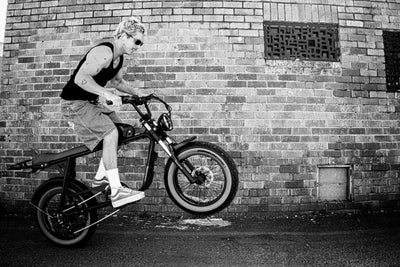BIKE USE, LAWS & SAFETY
Welcome to the Oceanside Team! As our valued customer, your livelihood and safety are important to us.
We are aligned with EBSA and can provide access to their comprehensive course designed to equip e-bike users with the knowledge, awareness, and habits needed to ride confidently in today’s traffic environments.
Whether you’re new to riding or looking to sharpen your skills, this course delivers practical, real-world training that promotes safety for both the rider and the community.
Riding Safely
To ensure you get the most out of your new Bike and stay safe, please take the time to read and understand the following information on bike use, laws and safety prior to using your product.
All bikes we sell are classified as bicycles, meaning there is no requirement for license or registration. Please ensure they are ‘road-legal’ mode when riding in public. Descriptions offer guidance for whether the product is intended for private use or on road.
An electric bicycle, also known as an E-bike, is a type of vehicle and can be assisted by power when riding.
You can ride an electric bike on all Queensland roads and paths, except where bicycles are prohibited. When riding, you have rights and responsibilities like all road users.
You must follow the bicycle road rules and obey the general road rules.
You don’t need a licence to ride an electric bike and they don’t need registration or compulsory third-party insurance.
Riding an Electric Bike
You propel an electric bike through pedalling with assistance from the motor. The motor is used to help you maintain speed while riding, and may be helpful when riding uphill or against the wind.
At speeds up to 6km/h, the electric motor can operate without you pedalling. The motor can help you when you first take off.
At speeds above 6km/h, you must pedal to keep the bicycle moving with the motor providing pedal-assist only.
When you reach a speed of 25km/h the motor must stop operating (cut out) and you need to pedal to stay above 25km/h like a bicycle.
Source of power
For an electric bike to be legally used on the road, it must have an electric motor and be one of the following:
1. A bicycle with an electric motor or motors capable of generating no more than 200 watts of power in total, and the motor is pedal-assist only.
2. A pedalec is a bicycle with an electric motor capable of generating up to 250 watts of power, but the motor cuts out at 25km/h and the pedals must be used to keep the motor operating. Pedalecs must comply with the European Standard for Power Assisted Pedal Cycles (EN15194) and must have a permanent marking on it that shows it complies with this standard.
Non-compliant electric bikes
Your motorised bike is non-compliant and can't be ridden on public roads or paths if it has any of the following:
- a petrol-powered or internal combustion engine
- an electric motor capable of generating over 250 watts (that isn't a pedalec)
- an electric motor that is the primary source of power.
For example, if your bike has a petrol-powered engine attached before or after purchase, it is non-compliant. If your bike’s electric motor can help up to speeds in excess of 25km/h without cutting off, it is non-compliant. If your bike has non-functioning pedals that do not propel the bike, it is non-compliant. If you can twist a throttle and ride your bike using the bike’s motor power only, without using the pedals, it is non-compliant.
Non-compliant bikes may only be ridden on private property with no public access.
If a non-compliant bike is to be ridden legally on a road, it must comply with the Australian Design Rules requirements for a motorcycle and be registered.
QLD & NSW OFFICIAL LINKS TO REGULATIONS: https://www.qld.gov.au/transport/safety/rules/wheeled-devices/bicycle
http://www.rms.nsw.gov.au/roads/registration/unregistered.html Bicycle
Road Rules and Safety Bicycles are a type of vehicle—when you ride a bicycle on a Queensland road, you have rights and responsibilities like all other road users.
When you ride a bicycle or power-assisted electric bike (also know as an e-bike) you must obey the general road rules the same as other motorists, as well as the specific road rules for bicycle riders. Electric bikes have additional rules you need to follow.
When you ride a bicycle, you must: • have 1 leg on each side of the seat
- face forwards
- keep at least 1 hand on the handlebars.
Carrying people You can carry another person if:
- the bicycle is designed to carry more than 1 person and has a passenger seat
- each person is wearing a helmet.
Signalling You must use a hand signal when you turn right. To do this, extend your right arm out horizontally—at a right angle from the right side of the bicycle. Your hand should be open, with your palm facing forward.
Towing with a bicycle You must not:
- ride a bicycle that is being towed by another vehicle
- hold on to a moving vehicle while riding a bicycle
- lead an animal while riding a bicycle.
Riding with a person in a bicycle trailer You can tow a child in or on a bicycle trailer if:
- you are 16 years or older
- the child is under 10 years old and is wearing an approved helmet that is securely fitted and fastened
- the bicycle trailer can safely carry the child.
Riding too close to a vehicle You must keep at least 2m between you and the back of a vehicle when you follow that vehicle for over 200m.
Being a traffic hazard You must avoid being a traffic hazard—do not ride into the path of a driver or pedestrian.
Keeping left and overtaking
When you ride, you must:
- ride as close as possible to the left side (or on the road shoulder) on a single lane road. Or, you may take up any position within the lane on a multi-lane road
- ride to the left of any oncoming vehicle
- not overtake another vehicle on the left if that vehicle is indicating and turning left
- not overtake another vehicle on the left if it is not safe
- not ride with more than 2 riders side by side unless you are overtaking another rider
- ride no more than 1.5m apart, if travelling beside another rider.
Bicycle helmets When you ride a bicycle or an electric powered wheeled recreational device or a personal mobility device like a rideable, you must wear an Australian Standard (AS) approved bicycle helmet. You must securely fit and fasten it. An approved bicycle helmet means a helmet that complies with AS 2063 or AS/NZS 2063.
You may only carry passengers on your bicycle if the bicycle is designed to carry passengers. If you carry a passenger on your bicycle, they must also wear an approved helmet, securely fitted and fastened. However, if they are a paying passenger on a 3 or 4 wheeled bicycle, they do not have to wear a helmet.
You do not need to wear a helmet if you have a doctor's certificate stating that, for a specific amount of time, you cannot wear a helmet:
- for medical reasons
- because of a physical characteristic that makes it unreasonable for you to wear one.
If you have a doctor's certificate, you must carry it with you when you ride without a helmet.
You also do not need to wear a helmet if you are a member of a religious group and are wearing a headdress customarily worn by your group, that makes it impractical to wear a helmet.
Bicycle equipment Every time you ride, your bicycle must have:
- at least 1 working brake
- a working bell, horn or a similar warning device.
Bicycle equipment for night time and unsafe weather
If you ride at night or in weather conditions that make it difficult to see, you must display (either on the bicycle or on you):
- a white light (flashing or steady) that can be clearly seen at least 200m from the front of the bicycle
- a red light (flashing or steady) that can be clearly seen at least 200m from the back of the bicycle
- a red reflector that can be clearly seen at least 50m from behind the bicycle—when a vehicle's headlights shine on it.
Carrying a load on a bicycle
You can carry a load on your bicycle. If you choose to carry a load, you must:
- attach the load to your bicycle in a way that does not make the bicycle unstable
Riding in a bicycle lane on a road
A bicycle lane is a marked lane with either a bicycle lane sign or a road marking of a bicycle symbol and the word 'lane' painted in white. The road may be painted green.
You can choose whether or not to ride in a bicycle lane where one is provided. You must not ride in a bicycle lane on the wrong side of the road (travelling towards oncoming traffic).
Bicycle and motorcycle riders are allowed to cross the first stop line to enter the bicycle storage area but must stop at the second stop line at a red traffic light. Motor vehicles, other than motorcycles, must stop at the first stop line.
A bicycle rider may choose to enter a bicycle storage area from a bicycle lane.
When you enter a bicycle storage area, you must:
- give way to anyone that is already in the bicycle storage area
- give way to any vehicle that is entering the area on a green or yellow traffic light.
Bicycle riding and mobile phones To keep yourself and other road users safe your full attention is needed when riding. Holding a mobile phone in your hand or resting it on any part of your body when riding is illegal—even if you're stopped in traffic. The phone does not need to be turned on for it to be an offence. When safely stopped, you can hold a phone to:
- pay for goods and services, for example at a drive through
- gain access to or from a road-related area, such as a car park
- present a digital driver licence or other document to police when asked
- get a card or money out of a phone wallet for the previous listed purposes.
You are allowed hands-free use of a mobile phone, for example, in a cradle attached to the bike. Hands-free can include to accept a call, use navigation apps or skip a song.
You can use a phone hands-free if it's in a pocket of your clothing or a pouch you're wearing. You must not touch or look at the phone. It can only be operated using your voice.
Penalties for bicycle riders There is no minimum age limit for the issuing of fines by the police.
Bicycle riders who break the road rules will be given the same fines as motorists, but will not accumulate demerit points. Offences common to both bicycle riders and motorists include:
- failing to stop at a red traffic light
- disobeying a 'no U-turn' sign at an intersection
- failing to stop at a 'stop' sign at an intersection
- using a mobile phone illegally
- exceeding the speed limit in a speed zone by less than 13km/h.
Common offences specific to bicycle riders include:
- carrying more passengers than a bicycle is designed for
- failing to give way to pedestrians on a footpath or shared path
- failing to display a light at night or in hazardous weather conditions
- failing to wear an approved helmet.
For any further queries, please talk to a member of our team or your local Transport and Main Roads department.







